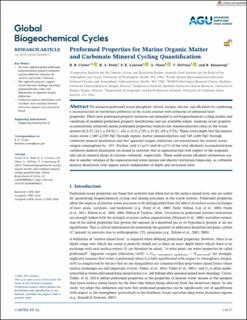| dc.contributor.author | Carter, Brendan R. | |
| dc.contributor.author | Feely, Richard A. | |
| dc.contributor.author | Lauvset, Siv Kari | |
| dc.contributor.author | Olsen, Are | |
| dc.contributor.author | DeVries, Tim | |
| dc.contributor.author | Sonnerup, Rolf E. | |
| dc.date.accessioned | 2022-04-05T07:49:21Z | |
| dc.date.available | 2022-04-05T07:49:21Z | |
| dc.date.created | 2021-04-30T12:17:55Z | |
| dc.date.issued | 2021 | |
| dc.identifier.issn | 0886-6236 | |
| dc.identifier.uri | https://hdl.handle.net/11250/2989791 | |
| dc.description.abstract | We estimate preformed ocean phosphate, nitrate, oxygen, silicate, and alkalinity by combining a reconstruction of ventilation pathways in the ocean interior with estimates of submixed layer properties. These new preformed property estimates are intended to aid biogeochemical cycling studies and validation of modeled preformed property distributions and are available online. Analyses of net property accumulations (observed minus preformed properties) indicate net remineralization ratios in the ocean interior of [1 P]: [14.1 ± 0.6 N]: [−141 ± 12 O2]: [95 ± 25 Si]: [89 ± 9 TA]. These ratios imply that the interior ocean stores 1,300 (±230) PgC through organic matter remineralization and 540 (±60) PgC through carbonate mineral dissolution and that apparent oxygen utilization can overestimate the interior ocean oxygen consumption by ~25%. Further, only 4 (±1%) and 46 (±5%) of the total alkalinity accumulated from carbonate mineral dissolution are found in seawater that is supersaturated with respect to the aragonite and calcite mineral forms of calcium carbonate, respectively. These small excess alkalinity inventories are due to smaller volumes of the supersaturated water masses and shorter ventilation timescales, as carbonate mineral dissolution rates appear nearly independent of depth and saturation state. | en_US |
| dc.language.iso | eng | en_US |
| dc.publisher | Wiley | en_US |
| dc.rights | Navngivelse 4.0 Internasjonal | * |
| dc.rights.uri | http://creativecommons.org/licenses/by/4.0/deed.no | * |
| dc.title | Preformed Properties for Marine Organic Matter and Carbonate Mineral Cycling Quantification | en_US |
| dc.type | Journal article | en_US |
| dc.type | Peer reviewed | en_US |
| dc.description.version | publishedVersion | en_US |
| dc.rights.holder | Copyright 2020. The Authors | en_US |
| dc.source.articlenumber | e2020GB006623 | en_US |
| cristin.ispublished | true | |
| cristin.fulltext | original | |
| cristin.qualitycode | 2 | |
| dc.identifier.doi | 10.1029/2020GB006623 | |
| dc.identifier.cristin | 1907445 | |
| dc.source.journal | Global Biogeochemical Cycles | en_US |
| dc.identifier.citation | Global Biogeochemical Cycles. 2021, 35 (1), e2020GB006623. | en_US |
| dc.source.volume | 35 | en_US |
| dc.source.issue | 1 | en_US |

